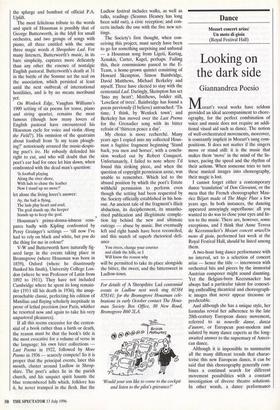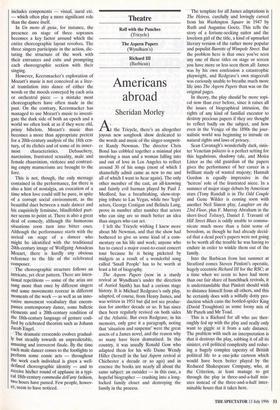Dance
Mozart concert arias/ Un moto di gioia (Royal Festival Hall)
Looking on the dark side
Giannandrea Poem
Mozart's vocal works have seldom provided an ideal accompaniment to chore- ography, for the perfect combination of voice and music does not require an addi- tional visual aid such as dance. The notion of well-orchestrated movements, moreover, is constantly implicit in Mozart's sung com- positions. It does not matter if the singers move or stand still: it is the music that makes them 'move' in the mind of the lis- tener, pacing the speed and the rhythm of their actions. When someone tries to turn these musical images into choreography, their magic is lost.
I cannot forget either a contemporary dance 'translation' of Don Giovanni, or the mess that the French choreographer Mau- rice B6jart made of The Magic Flute a few years ago. In both instances, the dancing appeared annoyingly superfluous: all you wanted to do was to close your eyes and lis- ten to the music. There are, however, some exceptions, and I think that Anne Teresa de Keersmaeker's Mozart concert ariaslUn moto di gioia, performed last week at the Royal Festival Hall, should be listed among them.
A two-hour long dance performance with no interval, set to a selection of concert arias — hence the title — interwoven with orchestral bits and pieces by the immortal Austrian composer might sound daunting. Yet the Belgian-born Keersmaeker has always had a particular talent for concoct- ing enthralling theatrical and choreograph- ic images that never appear tiresome or predictable.
And although she has a unique style, her formulas reveal her adherence to the late 20th-century European dance movement, referred to as nouvelle dance, danza d'autore, or European post-modern and saluted by many dance experts as the long- awaited answer to the supremacy of Ameri- can dance.
Although it is impossible to summarise all the many different trends that charac- terise this new European dance, it can be said that this choreography generally com- bines a continual search for different movement possibilities with a constant investigation of diverse theatre solutions. In other words, a dance performance includes components — visual, aural etc. — which often play a more significant role than the dance itself.
In Un mow di gioia, for instance, the presence on stage of three sopranos becomes a key factor around which the entire choreographic layout revolves. The three singers participate in the action, dic- tating the structure of the work with their entrances and exits and prompting each choreographic section with their singing.
However, Keersmaeker's exploration of Mozart's music is not conceived as a liter- al translation into dance of either the words or the moods conveyed by each aria or orchestral piece — a mistake most choreographers have often made in the past. On the contrary, Keersmaeker has managed to use Mozart's music to investi- gate the dark side of both an epoch and a world we often look at as if they were old, prissy bibelots. Mozart's music thus becomes a more than appropriate pretext for a 20th-century analysis of the 18th cen- tury, of its clichés and of some of its inner- most characteristics. Debauchery, narcissism, frustrated sexuality, male and female chauvinism, violence and contrast- ing empty mannerisms are brought to the fore.
This is not, though, the only message contained in the performance, for there is also a hint of nostalgia, an evocation of a time when love could still be pure, in spite of a corrupt social environment, as the beautiful duet between a male dancer and his exquisitely feminine, blindfolded part- ner seems to point at. There is also a great deal of comedy, although the humorous situations soon turn into bitter ones. Although the performance starts with the arrival on stage of a dancer who might be identified with the traditional 20th-century image of Wolfgang Amadeus Mozart, there is hardly any obvious reference to the life of the celebrated composer.
The choreographic structure follows an intricate, yet clear pattern. There are inten- tional repetitions — some of the arias are sung more than once by different singers and some movements reoccur in different moments of the work — as well as an inno- vative movement vocabulary that encom- passes contemporary dance, some balletic elements and a 20th-century rendition of the 18th-century language of gesture codi- fied by celebrated theorists such as Johann Jacob Engel.
The dramatic crescendo evolves gradual- ly but steadily towards an unpredictable, amusing and irreverent finale. By the time each male dancer comes to the footlights to Perform some comic acts — throughout the work each individual is given a well- defined choreographic identity — and to receive his/her round of applause in a typi- cal 18th-century commedia dell'arte fashion, two hours have passed. Few people, howev- er, seem to have noticed.



































































 Previous page
Previous page